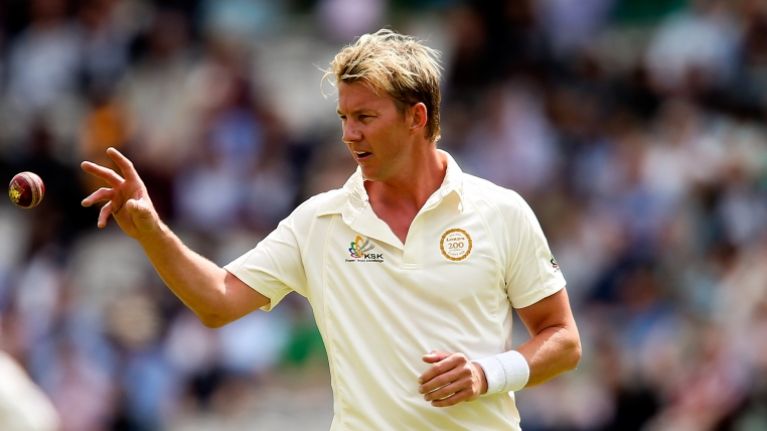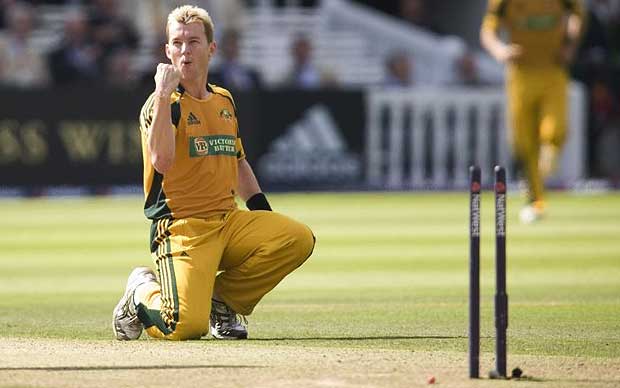In their tribute to Brett Lee, some call him the ‘blonde bombshell.’ There are others, for whom, he is a ‘blistering cannon.’
But no tribute to Brett Lee, among the finest bowlers of his generation, could ever sound complete without mentioning the difference he brought to the art of fast bowling during his stay.
We know he denied batsmen an easy day. We know he took pride in disturbing their concentration.
But is that all?
You regard McGrath for his uncanny accuracy in maintaining great line and length. You respect Gillespie for plotting the downfall of bowlers.
A re-run of Shoaib still gives you the kick to watch the domination of the ball over the bat while Ambrose and Walsh are your go-to men when it comes to hunting in the pair.
So what about Brett Lee?
Perhaps it may not be incorrect to suggest that Brett Lee assimilated all qualities that those mentioned above brought to the popping crease.
He may not have been a sorcerer like Warne.
But he could bowl at a perfect line and stick to it like McGrath. Often, it didn’t matter to him whether he was contesting on a bouncy surface or not for he could continuously bowl at one’s rib-cage like Shoaib. At a time where much of Australian bowling was about McGrath and Gillespie, Lee emerged as a lethal support bowler.
At the peak of their powers, during the mid-90s and late 2000s, when Australians attempted to drag batsmen into a cave of chaos, Brett Lee seemed an ever-ready digger of that grave.
Make no mistake.
It wasn’t that Brett Lee cramped batsmen for any room.
Conceding a couple of boundaries of batsmen who often merely pushed the ball and made use of his thundering pace defined Lee in the early years.
Often, many a batsman got away in throwing the bat at deliveries that seemed positioned more toward the second slip instead of the usual line.
But Lee had the heart and possibly, the confidence of bringing the next one sharply in.
And perhaps, it was this decisiveness on his part and the total unpreparedness on those who were against him that defined Brett Lee.
What endears fast bowlers to their fans isn’t just pace or swing. Possibly, it’s their heart to battle it out and readying themselves for the grind despite being picked for runs that provide a litmus test of their character.
Lee, 690 international wickets, including a hat-trick in a world cup (2003), and an unforgettable 5-f0r at Lord’s appeared for this test time and again.
Each game he played, regardless of whether he ended up on the winning or the losing side, Brett Lee bowled his heart out.
While an early introduction into facing the tremors of devastating batting pegged a young 23-year-old vis-a-vis arguably against India’s best batting order, featuring Laxman, Ganguly, Dravid, and Tendulkar, it was the Test debutant’s 5-for at the MCG that showed India who they were up against.
He wasn’t a good-l00king rock guitarist disguised in the jersey of a cricketer.
He was to be a bowler who’d know how to produce chin music.
 Lee’s next big achievement, following a solid MCG debut, came only four years into his career, when aged just 27, he returned to one of his favorite hunting grounds where he began his journey and would reduce England into a clueless bunch. It was January 2003 when against an Anderson, Flintoff, Hussein, Vaughan-powered England that Brett Lee would clink glasses with his victorious teammates having taken a fiery 5 for 30.
Lee’s next big achievement, following a solid MCG debut, came only four years into his career, when aged just 27, he returned to one of his favorite hunting grounds where he began his journey and would reduce England into a clueless bunch. It was January 2003 when against an Anderson, Flintoff, Hussein, Vaughan-powered England that Brett Lee would clink glasses with his victorious teammates having taken a fiery 5 for 30.
That said, what attracted one toward Lee was the considerable success he garnered with painstaking tedium despite waging wars on two separate fronts.
While on the one hand, he was up against some leading blades of their times, Mohd. Younus, Brian Lara, Sachin Tendulkar, Jack Kallis, and Graeme Smith, he was constantly trying to sway a rabid spell of physical anomalies that threatened to truncate his run in the sport.
There was no tendon he hadn’t swelled, no ligament he didn’t break and no ache he didn’t muster enough fight to counter. But he somehow found a way to continue being the pace bowling sensation that proved spectators that Aussies were more than Mark Waugh’s silken drives, McGrath’s cunning accuracy, and Warne’s showmanship.
A couple of months later following his MCG assault of 2003, continuing his scourge over Queen’s England, this time, in England, he’d clinch another famous five-for.
This time, he’d lord at the Lord’s cricket ground.
Just when you thought this was his greatest cricketing achievement, he went ahead and gathered a hat-trick in the 2003 World Cup against Kenya.
Regardless of the haplessness of the opponent, the spectator was a bit baffled to find in the same instant of viewing Lee clinching Obuya, the shorter one eclipsing the right-hander’s elbow only to trickle down to the stumps, exasperation, and upliftment. The delivery was hurled at a mighty 148 k/hr.
Throughout the tournament, Lee bowled with nagging pace and went on to collect 22 wickets at an average of 17. Where was another ODI bowler who exhibited figures of a five-dayer?
If there was a living embodiment of the dangers of playing on a WACA, then Brett Lee was it.
And mustn’t we forget that to gather all that he eventually did- 211 ODI wickets away from Oz, 50 plus ODI scalps each against England, India, and Pakistan, Lee didn’t terrorize batsmen on account of imposing physicality.
He wasn’t scary like an intimidating Ambrose.
His presence wasn’t overwhelming like an angry Donald.
This proponent of (a clever brand of) fast bowling, magnified by that ability to deliver skiddy bouncers at a dead accurate angle, was at best, a smiling assassin who derived senile pleasure by making batsmen play and miss.
He was a Tom Cruise-kind ambassador for the sport who seemed a perfect selfie-material long before an Aussie coined the term.
But look within a perplexed Lara- picture the Prince of Trinidad going airborne on way to his 2003 century to avoid a bouncer- and see Flintoff with his stumps shattered- you’d find Lee was every bit a warrior as he was an exceptionally beguiling opponent.

